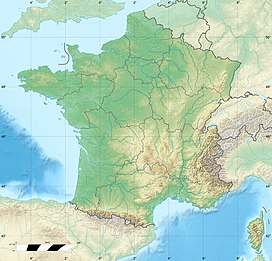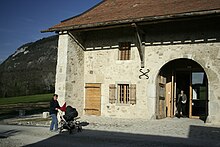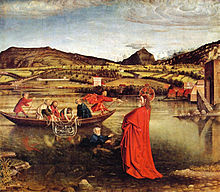(1) Thăm núi Salève (Pháp) nằm sát Genève:
Thông tin qua Wikipedia
Thông tin qua Wikipedia
| Mont Salève | |
|---|---|
 Panorama view of the Salève |
|
| Elevation | 1,379 m (4,524 ft) |
| Location | |
|
Haut-Savoie, Rhône-Alpes, |
|
| Range | French Prealps |
| Coordinates | 46°05′39″N 6°08′25″ECoordinates: 46°05′39″N 6°08′25″E |
| Geology | |
| Age of rock | Jurassic to Cretaceous |
The Salève is a mountain of the French Prealps located in the departement of Haute-Savoie (France). It is also called the "Balcony of Geneva".
Contents |
Geography
Geographically, the Salève is a mountain of the French Prealps located in the department of Haute-Savoie, but geologically, it is part of the Jura chain, similar to the Vuache.In the plane north of the Salève, the agglomeration of Geneva is located where more than 700,000 people live.
The Salève consists of the Pitons, the Grand and the Petit Salève and cluminates at 1379 meters at the summit of the Grand Piton. Accessible via a cable car,[1] since 1932 which was reconstructed in 1983, the Salève is located between Étrembières in the north and the suspension bridge de la Caille in the south. Between 1893 and 1935, the Salève was served by the first electrical rack railway in the world.[2]
The eastern side of the Salève dives under the molasse of the Plateau des Bornes such that the mountain slope facing Geneva, subject to erosion is abrupt. The vegetation or its absence highlights the layers of limestone. The mountain has several narrow and deep gorges among them the Varappe which at the end of the 19th century gave its name to the activity of climbing in French. An intense activity developed at this point in a time when this discipline was in its beginnings.
The valley of Monnetier which separates the Petit and the Grand Salève is due to glaciary erosion. Currently, geologists think that the valley of Monnetier was created by the subglacier currents in a fissured region between the Petit and the Grand Salève and not by the Arve.
From prehistory to green tourism
Between 12,000 and 10,000 BC, the Salève hosted a magdalenian site.[3] Since 1833, the Geneva medicine François Isaac Mayor, then the pastor Taillefer and the dentist Thoily explored the past of the mountain. The rocks close to Veyrier revealed themselves having been a shelter. Bones (partridge, reindeer, horse, marmot...), flint and engraved wood was found in a dozen of places, grottes, shelters or settlements. A dolmen was at Aiguebelle.Between the Neolithic and the Bronze age, the settlements became more sedentary (Bossey, Chaffardon). An oppidum was erected on the Petit Salève around 1000 BC.
The Salève offers a magnificent panorama over the Geneva agglomeration, Lake Geneva, the south of the Jura mountains, the Prealps, Lake Annecy and the Mont Blanc. It is used for leisure time activities by the inhabitants of Geneva due to its proximity to the city (for this reason it is often called the "mountain of the Genevans"). One can practice rock climbing, hiking, mountain biking, paragliding, hang gliding, model aircraft, speleology as well as skiing at the Col de la Croisette. It can be accessed from the center of Geneva by public bus (No. 8, 34, 41) to Veyrier-Ecole or Veyrier-Douane. While the Salève is open to everybody for free, it also hosts agriculture - the cows of the Salève supply Geneva with milk - and forestry.
"Le syndicat mixte du Salève" and the "Maison du Salève"
The "Syndicat mixte du Salève" was created in 1994 and regroups the twenty communes on whose ground the Salève os located. Its objective is to appreciate and protect the mountain which is a "preserved island" in the middle of a French-Suisse territory that is highly urbanized with more than 700.000 inhabitants.The syndicat opened the "Maison du Salève" in September 2007 in an ancient Mikerne farm house dating from 1733. This documentation center presents all aspects of the mountain: its history, patrimony, nature, sports and leisure. In the same year, it developed a charter for sustainable development of the Salève trying to reconcile the conservation of the massif with its increasing frequentation with a vision of 30 years. The "Maison du Salève" hosts a permante exposition, temporary exhibitions as well as guided tours, excursions and conferences about the local patrimony and the environment.
The syndicat involves in its three work groups - agriculture, tourism and leisure, access and transportation - all users of the Salève, i.e., communes, sport clubs, environment protection associations, restaurations, farmers, hunters, tourism offices etc.
Place of Cult
Shedrub Choekhor Ling is a center of Tibetan Buddhism located on the Salève.The Salève in the literature
- In Frankenstein by Mary Shelley, the creature after having fled climbs up the Salève (Chapter 7).
| “ | It was echoed from Saleve, the Juras, and the Alps of Savoy; vivid flashes of lightning dazzled my eyes, illuminating the lake, making it appear like a vast sheet of fire; then for an instant everything seemed of a pitchy darkness, until the eye recovered itself from the preceding flash. | ” |
| “ | I thought of pursuing the devil; but it would have been in vain, for another flash discovered him to me hanging among the rocks of the nearly perpendicular ascent of Mont. Saleve, a hill that bounds Plainpalais on the south. | ” |
| “ | Who could arrest a creature capable of scaling the overhanging sides of Mont Saleve? | ” |
The Salève in paintings
The Salève occurs on the first picture depicting a realistic countryside, La Pêche Miraculeuse of Konrad Witz created in 1444.Photo gallery
-
The Salève (left) and the agglomeration of Annemasse
-
The Salève seen from Annecy
-
Aerial view on the Salève and Geneva, its Jet d'Eau, Lake Geneva and the Jura mountains in the background
-
The Mont Blanc from the summit of the Salève
-
Night view on St-Julien from the Salève
References
- ^ "La station supérieure du téléphérique" located at 1100 meters is a work of the swiss architect Maurice Braillard.
- ^ Chemin de Fer du Salève
- ^ Histoire des communes savoyardes, tome III, Le Genevois et Lac d'Annecy, de Jean-Yves Mariotte, Henri Baud, Jean-Bernard Challamel et Alain Guerrier, éditions Horvath, 1978.















Không có nhận xét nào:
Đăng nhận xét